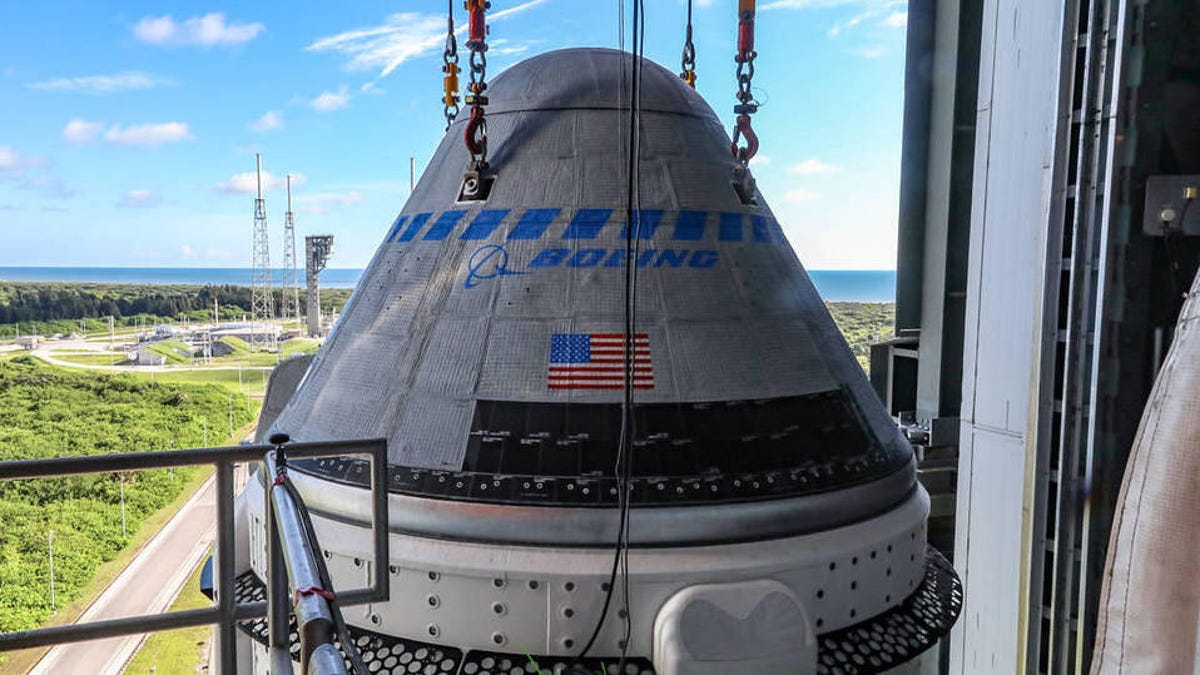Troubled Boeing Starliner headed back to factory, further delaying NASA launch
A persistent valve problem remains after the issue scrubbed a second launch attempt earlier this month.

Boeing CST-100 Starliner spacecraft sits atop a ULA Atlas V rocket in July 2021.
After more than a week trying to fix a problem with stuck valves, Boeing's Starliner crew capsule is coming off the Atlas V rocket that was meant to send it to orbit for some "deeper-level troubleshooting." In a call with media on Friday, NASA's Steve Stich said Starliner now won't be able to undertake its test flight to the International Space Station until late October at the earliest.
Boeing had hoped to launch Starliner on Aug. 3 in an attempt to dock with the ISS, but the attempt was scrubbed -- the second delay in less than a week. Boeing's first try way back in December 2019 failed to reach the correct orbit but gave it valuable data.
Engineers "detected unexpected valve position indications in the propulsion system" during a health check of the spacecraft after electrical storms in the region, Boeing said at the time. It remains uncertain if the storms were responsible for the technical issue.
The spacecraft was moved off the pad and returned to a hangar (or "vertical integration facility") on Aug. 4 but as of Friday, four valves were still malfunctioning, forcing Boeing to de-stack the vehicle to get a better look at the problem.
"We'll continue to work the issue from the Starliner factory," Boeing's Commercial Crew Program manager John Vollmer said.
He also cast some doubt on the possibility that the capsule will get off the ground in 2021: "It's probably too early to say whether it's this year, or not."
The mission was originally scheduled to take off July 30, but that was delayed due to an issue Thursday with a Russian ISS module firing its thrusters shortly after docking with the station. That knocked the space station around and forced teams to evaluate the station's status.
When Starliner does finally launch, it will lift off on a United Launch Alliance (ULA) Atlas V rocket. The capsule will be packed with around 400 pounds of crew supplies and cargo. If all goes well, it'll dock with the space station about 24 hours later. Docking will also be covered live by NASA TV.
Software defects and a communications link problem led to a premature end to the original Boeing test flight in 2019, though the CST-100 Starliner capsule landed safely back on Earth. The upcoming Orbital Flight Test-2 (OFT-2) mission is a chance for Boeing to thoroughly vet its hardware and software before a crew of three American astronauts would fly on Starliner.
Both Boeing and SpaceX are part of NASA's Commercial Crew Program, which is all about sending astronauts to the ISS from American soil. SpaceX has now delivered 10 astronauts to the ISS, and Boeing would like to catch up. But first, it'll need to show that its Starliner can safely reach the ISS and return to Earth.
Starliner will spend between five and 10 days at the ISS before bringing research samples back to Earth. Boeing will aim to bring the spacecraft back for a parachute landing in the desert of New Mexico.
"OFT-2 will provide valuable data that will help NASA certify Boeing's crew transportation system to carry astronauts to and from the space station," NASA said in a statement July 22 after concluding a flight readiness review.
The mission is a key step for NASA's plans to run regular crewed launches from the US, ending its reliance on Russian Soyuz spacecraft. Boeing is also looking ahead at its first crewed mission, Boe-CFT, which it had been hoping to launch within the next six months. The delays with OFT-2 could mean a longer wait before people fly on Starliner.
Follow CNET's 2021 Space Calendar to stay up to date with all the latest space news this year. You can even add it to your own Google Calendar.





